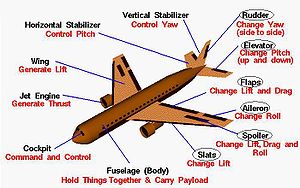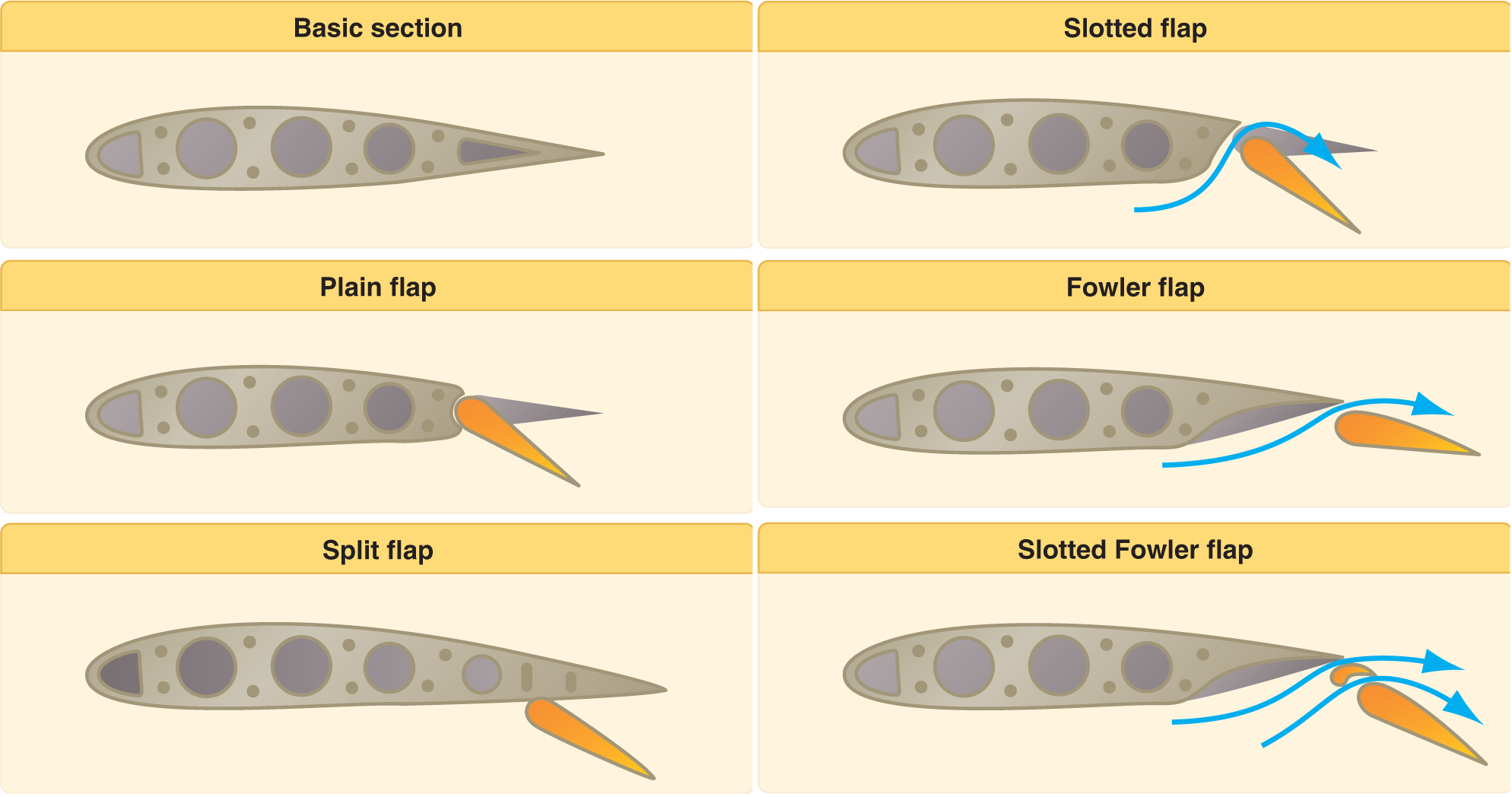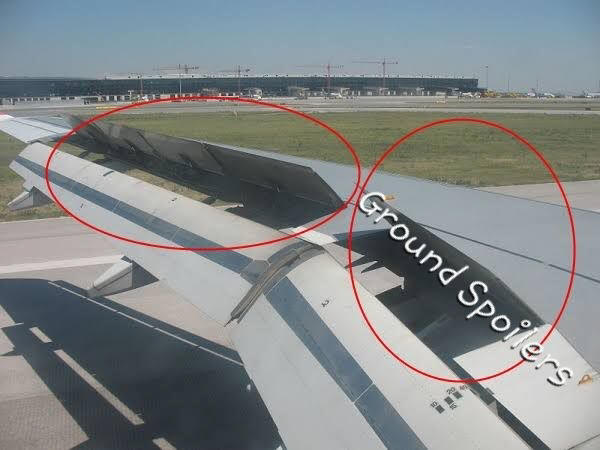The basic parts of an
airplane
The basic parts of an airplane include the
fuselage, wings, empennage, powerplant, and landing gear. There are also
subparts of those major parts that are crucial to enabling a plane to fly as
well as various systems that keep the plane running safely and the passengers
comfortable.
Fuselage
The fuselage is the main part of the plane, located
centrally to the entire aircraft. The fuselage, which is basically a large,
hollow tube that tapers at the back, is the component where the passengers and
baggage are held and to which the wings and empennage are attached. The fuselage
also includes the cockpit, where the pilot and copilot control the plane.
Wings
The wings are the source of lift for the aircraft.
They are attached on both sides of the fuselage, near the top on high-wing
aircraft like the Cessna 162 and at the bottom on low-wing aircraft, such as the
DR400. The front of the wing is called the leading edge, and the
back of the wing is called the trailing edge.
The wings are held together and supported by metal
spars, ribs, and stringers and covered by a fabric, aluminum, or composite
material shell. On their trailing edges, you can find the ailerons and flaps,
which change the shape of the wings for different phases of the flight.
Ailerons are found near the tips of wings' trailing
edges. They're rectangular-shaped airfoils that rise to disturb the airflow over
the wing. Ailerons are used to turn the airplane by creating more lift on one
wing than the other.
Flaps are smaller airfoils found on the rear parts of
the wings nearest to the fuselage. Flaps can be extended to increase the wing
surface area, creating more lift for takeoff and landing. There


are different types of flaps because designs vary by aircraft. The most common
are the plain flap, slotted flap, split flap, Fowler flap, and double-slotted
Fowler flap.

.
On wings' leading edges, you can find slats, which
serve the same purpose as flaps: increasing surface area to create more lift for
takeoff and landing.
On the upper surfaces of wings are spoilers, which are
small, hinged plates that serve multiple purposes: If both spoilers (one on each
wing) are lifted up, or deployed, they can slow the plane or make it descend. If
the spoiler on one wing is deployed, it can make the plane roll. If the spoiler
on the right wing (the wing to the right of the forward-facing pilot) is
deployed, the plane will roll in a clockwise direction. The spoiler on the left
wing makes the plane roll in a counterclockwise direction when it's deployed.

Many planes have wings with vertical tips called
winglets that reduce drag and enable the wings to produce lift more efficiently.
Sur les bords d'attaque des ailes, vous pouvez trouver
des becs qui ont la même fonction que les volets: augmenter la surface pour
créer plus de portance pour le décollage et l'atterrissage.
Les spoilers sont de petites plaques articulées qui
servent à plusieurs usages: si les deux spoilers (un sur chaque aile) sont levés
ou déployés, ils peuvent ralentir l’avion ou le faire descendre. Si l'aileron
d'une aile est déployé, il peut faire rouler l'avion. Si le spoiler de l'aile
droite (l'aile à droite du pilote orienté vers l'avant) est déployé, l'avion
roulera dans le sens des aiguilles d'une montre. Le spoiler de l'aile gauche
fait rouler l'avion dans le sens inverse des aiguilles d'une montre lorsqu'il
est déployé.
De nombreux avions ont des ailes à extrémités
verticales appelées winglets qui réduisent la traînée et permettent aux ailes de
produire une portance plus efficace.


Empennage
The empennage, or tail section, consists of the
vertical stabilizer and the horizontal stabilizer.
The rudder is a movable piece of the vertical
stabilizer that allows the airplane to turn left or right about the airplane's
vertical axis when activated. The rudder is connected to the foot pedals in the
cockpit of the airplane.
The elevator is located on the rear part of the
horizontal stabilizer. It moves up or down in order to make the plane's nose
move up or down. The elevator is connected to the yoke. If you were to pull back
on the yoke in the cockpit, the elevator would be moved upward, forcing the
horizontal stabilizer to go down and the aircraft's nose to go up.
Trim tabs are small rectangle-shaped pieces of
material that may be found on the trailing edges of the horizontal and vertical
stabilizers. They're meant to be moved gradually, as set by the pilot, to ease
control pressure and make the aircraft easier to handle.
A stabilator is a type of horizontal stabilizer that
doesn't include an elevator and requires less effort by the pilot to bring about
changes in the control of the aircraft. A stabilator is one large piece of
material with an anti-servo tab on its leading edge that doubles as a trim tab.
The purpose of the anti-servo tab is to prevent overcontrolling—making too many
corrections to control the plane.
L'empennage, ou section de queue, comprend le
stabilisateur vertical et le stabilisateur horizontal.
Le gouvernail est une pièce mobile du stabilisateur
vertical qui permet à l'avion de tourner à gauche ou à droite autour de l'axe
vertical de l'avion lorsqu'il est activé. Le gouvernail est connecté aux pédales
dans le cockpit de l'avion.
L'ascenseur est situé à l'arrière du stabilisateur
horizontal. Il monte ou descend pour faire monter ou descendre le nez de
l'avion. L'ascenseur est connecté au joug. Si vous tiriez sur la bascule dans le
cockpit, l'ascenseur serait déplacé vers le haut, ce qui obligerait le
stabilisateur horizontal à descendre et le nez de l'avion à monter.
Les onglets de rognage sont de petites pièces de
matériau en forme de rectangle que l'on peut trouver sur les bords de fuite des
stabilisateurs verticaux et horizontaux. Ils doivent être déplacés
progressivement, comme défini par le pilote, afin de réduire la pression de
contrôle et de rendre l’appareil plus facile à manipuler.
Un stabilisateur est un type de stabilisateur
horizontal qui ne comprend pas d'élévateur et demande moins d'effort à la base
des modifications apportées par le pilote pour modifier le contrôle de
l'aéronef. Un stabilisateur est un gros morceau de matériau avec une languette
anti-servo sur son bord d'attaque qui sert également de languette de coupe.
L'onglet anti-servo a pour but d'empêcher tout contrôle excessif, en effectuant
trop de corrections pour contrôler le plan.
Powerplant
The powerplant consists of the engine or engines,
perhaps a propeller (depending on the type of engine), and the electrical
system. It can be located in/on the front of the aircraft fuselage or toward the
rear of the airplane. In multi-engine aircraft, the engines are typically
located under the wings on each side.
The engine is typically covered by a cowling that
helps streamline the flow of air around the engine and keep it cool.
Le groupe motopropulseur comprend le ou les moteurs,
peut-être une hélice (selon le type de moteur), et le système électrique. Il
peut être situé dans / à l'avant du fuselage de l'avion ou vers l'arrière de
l'avion. Dans les avions multimoteurs, les moteurs sont généralement situés sous
les ailes de chaque côté.
Le moteur est généralement recouvert d'un capotage qui
aide à fluidifier le flux d'air autour du moteur et à le maintenir au frais.
Landing Gear
The landing gear on most aircraft consists of wheels
and struts. Some aircraft have skis or floats in order to land on snow or water,
respectively.
Most single-engine land airplanes have tricycle
landing gear. Tricycle gear consists of two main wheels with a nose wheel in
front. On aircraft with conventional gear, which, despite its name, is much less
common, there are two main wheels with a single wheel in back, under the tail.
Aircraft with conventional type gear are often called tailwheel airplanes or
taildraggers.
Disc brakes are located in the main wheels and are
usually controlled with the pilot's feet.
Le train d'atterrissage de la plupart des aéronefs est
constitué de roues et de jambes de force. Certains aéronefs ont des skis ou des
flotteurs pour atterrir sur la neige ou sur l'eau, respectivement.
La plupart des avions terrestres monomoteurs ont un
train d'atterrissage tricycle. Le tricycle est composé de deux roues principales
avec une roue avant à l'avant. Sur les aéronefs à engins conventionnels, qui,
malgré son nom, est beaucoup moins répandu, il y a deux roues principales avec
une seule roue à l'arrière, sous la queue. Les aéronefs avec des engins de type
conventionnel sont souvent appelés avions à roues à queue ou timoniers.
Les freins à disque sont situés dans les roues
principales et sont généralement contrôlés par les pieds du pilote.
Aircraft Frames
Aircraft can be made of different types of material
and with different methods, including truss, monocoque, semi-monocoque, and
composite material.
A truss structure is an older type of structure and is
created by welding tubes together to form a rectangular frame. It can be left
open or covered by a cloth or metal skin but is not as aerodynamic as more
current methods.
Monocoque structures are basically hollow designs with
a stretched fabric or material such as aluminum over the open framework. They're
simple and pretty sturdy around the edges, but the inner parts of these
structures can't withstand much external pressure.
Semi-monocoque airplanes are designed in a similar
fashion as monocoques but with added support and a substructure.
Composite materials are becoming more popular and are
frequently used in modern aircraft. Composite materials such as carbon fiber and
fiberglass are lighter and stronger than traditional aluminum. They're more
expensive but are less prone to corrosion and metal fatigue.
Other Systems
The pilot uses the hydraulic system to control the
ailerons, flaps, slats, spoilers, rudder, and elevator. In a smaller aircraft,
the hydraulic system may be used for braking and other operations.
The pressurization and oxygen systems are used in
large aircraft that fly at high altitudes to maintain cabin pressure and supply
enough oxygen for everyone on board.
The fuel system stores clean fuel in tanks and
transports it to the carburetor.
The carburetor system mixes fuel and air for use by
the engine or engines.
Anti-icing and deicing systems prevent ice from
forming and remove ice, respectively.
The heating and air-conditioning system keeps the
aircraft warm or cool enough for the comfort of passengers.



